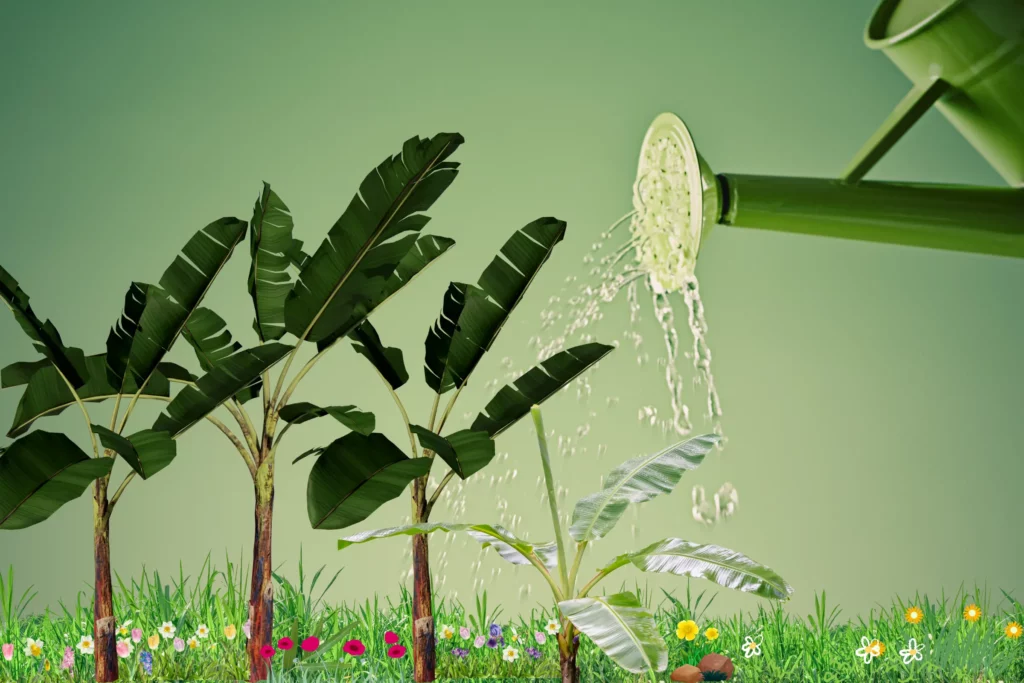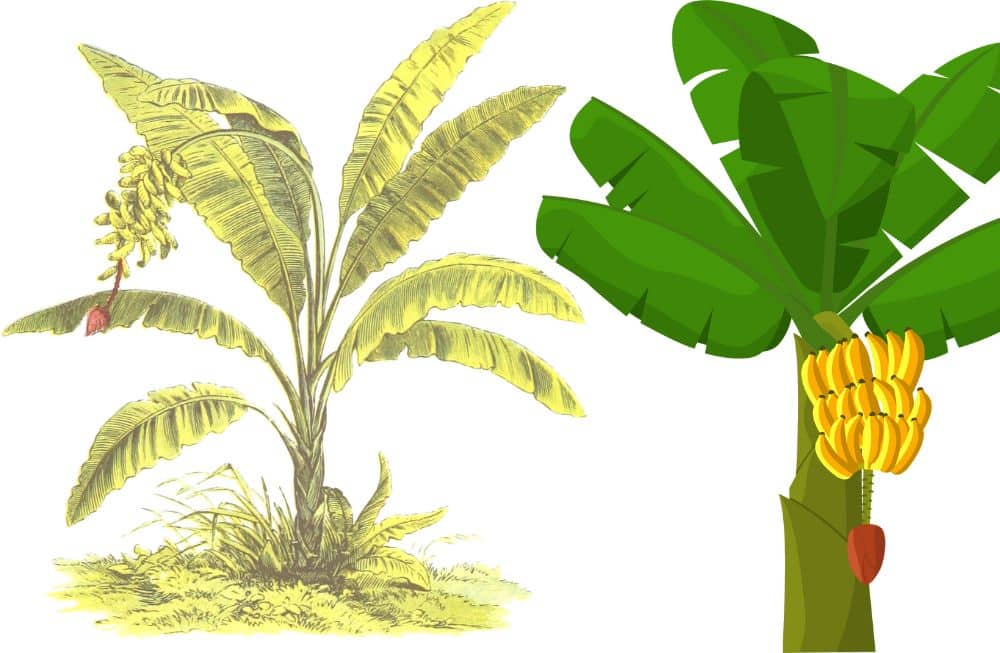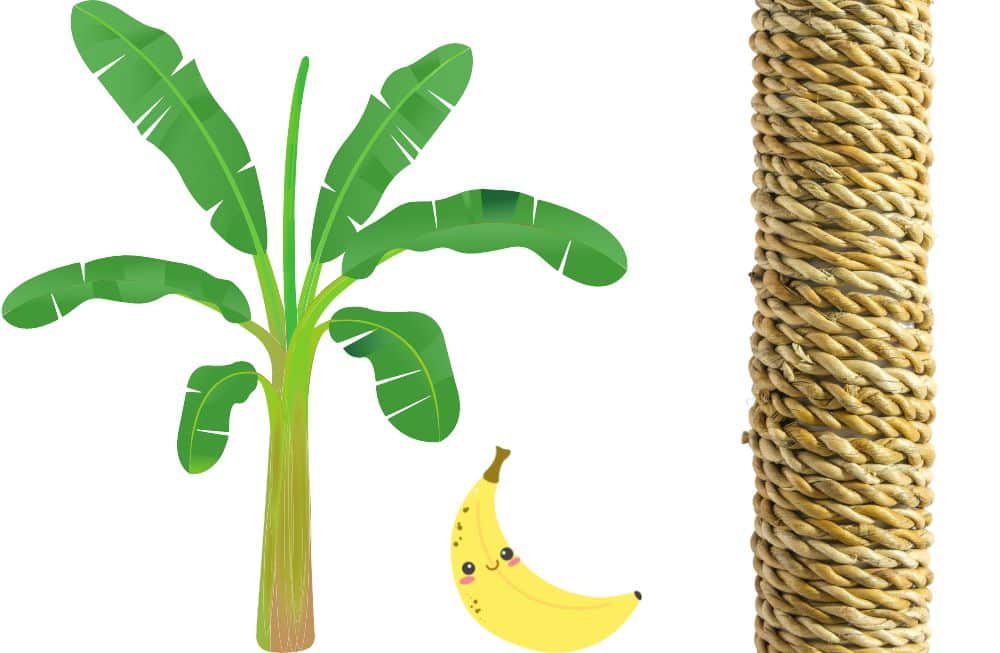Keeping banana plants healthy is a challenge for many gardeners. Overwatering banana plants is a common problem. Overwatering can harm your banana plants their growth and even kill them.
Here we will explain the signs of overwatering your banana plants and provide tips on preventing it. We will discuss everything from soil moisture levels to drainage issues and watering frequency to ensure your banana plant thrives. Read on , if you want your banana plant to live a long, healthy life.
Can You Overwater Banana Plants?
No. You can not overwater your banana plants. Overwatering is a common mistake when growing banana plants. It is necessary to water regular plants regularly, but too much water can harm them.
What Are The Signs Of Overwatering Banana Plants?
When a banana plant is overwatered, you will notice yellowing leaves, dropping leaves, softening stems, power mildew growing, mushy leaves, brown spots, moldy leaves, and heavy and moist soil.
Leaves Turning Yellow
Yellowing leaves are one of the symptoms of an overwatered banana plant. Standing water can cause the plant’s roots to become waterlogged and rot. Eventually, the leaves become yellow and fall off. It may also produce fewer fruits and flowers, indicating that the plant is unhealthy.
Drooping Leaves
Drooping leaves are another sign of overwatering. Plants cannot absorb nutrients when their roots are soggy. Consequently, the plant’s leaves will droop and wilt. If you see these symptoms, take action immediately to save your plant. It may also stop growing completely.
You will see wilted, tired, and overwhelmed leaves. There would also be a little foliage loss, but it looks as if their neck is hung.
Stem Or Trunk Softening
Overwatered plants often have soft stems and trunks. The plant collapses due to waterlogging. Pests and diseases are also more likely to attack plants that are overwatered.
A banana plant with a soft stem or trunk is another sign of absorbing too much water. Additionally, each stem’s structure would be elastomeric and tired.
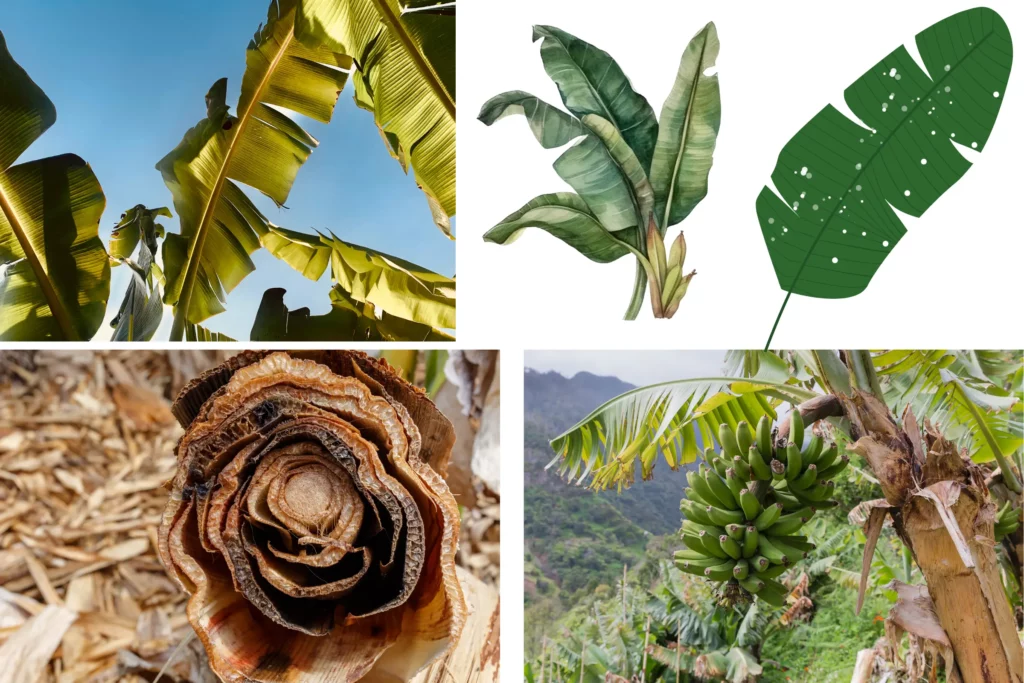
Powdery Mildew
Bananas are susceptible to powdery mildew, a fungal disease. Symptoms of the disease include white or grayish yet white powdery growth on the affected plants’ leaves, stems, and fruit.
The most common cause of powdery mildew is overwatering, especially if the leaves remain wet for an extended time. You should immediately act if you suspect your banana plant suffers from powdery mildew.
Brown spots on leaves
Overwatered banana trees have brown spots or patches on their leaves. There may also be yellowing and wilting of the leaves. Moreover, if the plant is overwatered, the roots will not receive the proper amount of oxygen and will start to rot. As a result, the plant would suffer from fungal growth and diseases and eventually die.
Water your banana plant only when the soil feels dry to the touch. You should adjust your watering schedule if you see any signs of overwatering, such as brown spots on the leaves.
Moldy or heavy soil
You may have overwatered your banana plant if you notice heavy or moldy soil around it. Waterlogged soil is difficult to work with on overwatered plants. The mold or mildew is another indication that the plant lacks proper airflow. Overwatering and mold can both kill banana plants.
Because the soil is high in humidity and that texture is what the mold needs to multiply, it would easily propagate, grow, and slowly exhaust the plant’s soil.
Moist soils
Waterlogged soil, suffocated roots, and death are symptoms of too much moisture. A plant’s roots suffocate when submerged in water for an extended time.
A lack of oxygen stunts root growth and prevents the plant from absorbing necessary nutrients. As a plant’s food supply diminishes, its leaves will turn yellow and drop off.
The plant will eventually die if the problem is not resolved. Fungal growth can also be facilitated by too much water. Plant diseases are caused by fungi that thrive in wet conditions. Consequently, keeping your soil from becoming too wet around your plants is important. You may end up with a dead plant otherwise.
How To Save An Overwatered Banana Plant?
It is important to take steps to improve the soil’s drainage, reduce the amount of water the banana plant receives, adjust the watering schedule, check the moisture level, and use mulch to trap moisture.
Drainage Improvements
Improved soil drainage will prevent water from sitting in the plant’s roots, which can lead to root rot. Banana plants can benefit from some drainage improvements. Organic matter can improve drainage if your plant is constantly overwatered. To improve drainage, you can also add perlite or vermiculite to the soil.
It is important to take corrective action immediately if you suspect your banana plant is overwatered. Consider increasing the pot’s drainage and letting the soil dry completely between watering sessions. If your banana plant is overwatered, it will recover properly.
Mulch can improve soil drainage if the plant does not receive sufficient water from the roots. By doing so, you can hold in moisture and improve the soil’s drainage. Gravel can also be added to the bottom of the pot to improve drainage. Your banana plant will remain healthy and thrive if you improve its drainage.
Dry Out The Soil
Ensure the soil is completely dry before nightfall by letting it dry out between waterings. Furthermore, space your banana plants farther apart to improve air circulation and prevent overcrowding. Affected leaves can also be removed and disposed of to prevent the spread of the disease.
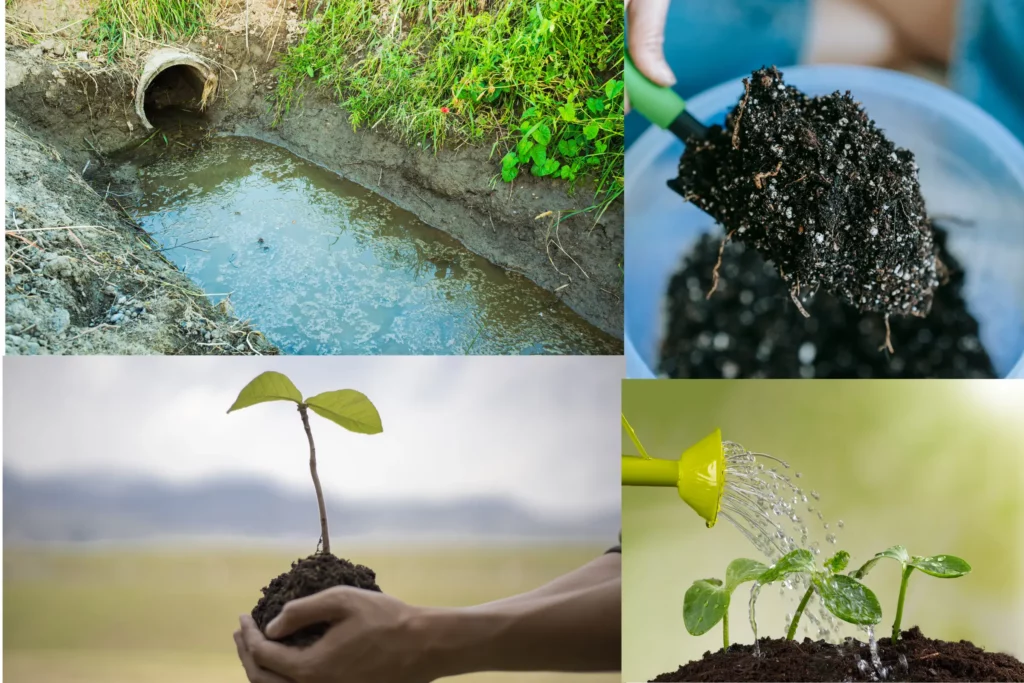
Maintain A Moisture Level
Check the soil’s moisture before watering to ensure the plant doesn’t get too much water.
It is optional to water the plant again if the soil is already moist. To test this, place your finger close to your second knuckle in the soil. Moisture in the soil indicates that your plant is getting enough water.
Once your soil has been adjusted, you should water your plant four to six inches monthly. Also, ensure that your plant has good drainage so excess water can drain away from the roots.
The yellowing or browning of your plants’ leaves indicates you were overwatering them.
Schedule Your Waterings
Make a watering schedule for your banana plant and follow it to avoid overwatering. As a result, the plant will receive the right amount of water. Make sure you keep a monthly schedule in order to avoid overwatering.You can water it up to six inches every month, and it will survive.
Stop watering the plant altogether as the first step. Giving the plant a chance to dry out may seem counterintuitive, but it will help it recover. After the soil has dried, you can water the plant again, but be careful not to overwater. Your plant will likely do much better if you water it every other week.
You can even water the plant early in the day to allow it to dry out before the night falls. Fungal diseases are more likely to develop on wet leaves.
Remove Damaged Leaves Or Stems
When the stems or leaves of the plant become mushy or soft, cut them off near the roots and wait a few days. Any leaves with brown marks or tears should be removed.
The banana plant grows from a rhizome, a root system that sends multiple new stems. By removing the old stems, new growth will be stimulated. It is possible to see stems within a few weeks if this is done in the warmer spring and summer months.
Within two weeks of cutting an old stem off, my banana plant would send a new one. My preference is to keep mine to 3-4 main stems. As a result, the plant will concentrate its energy on a few stems and produce more bananas.
Banana Plant Repotting
You will likely need to report your banana plant. Repotting is the only way to save it from root rot. For indoor banana plants, you will need a new pot, pruners or scissors, and sterilizing solution.
For indoor banana plants, you will need a new pot, pruners or scissors, and sterilizing solution. Cut off any damaged or discolored banana plant rhizomes with your pruners or scissors.
A banana plant requires fertile, deep, and well-draining soil. Perlite can be added to ensure good drainage. You should add a layer of mulch on top of the banana soil since it needs a lot of nutrients.
Repotting banana plants causes transplant shock, like repotting any other potted plant. It is important to keep the soil moist after repotting. Stick to a proper watering schedule to avoid drowning.
How Often Should I Water A Banana Plant?
Water banana plants deeply and slowly every two to three days during warm weather. If necessary, you can water them daily. It is important to check the soil’s top inch of soil before watering banana plants.
During the cooler months, banana plants grow the most; once the temperature crosses 50 degrees, they stop growing. Ensure they don’t stand in still water since too much watering can lead to root rot.
How Much Water Does A Banana Plant Need?
A banana plant needs 4-6 inches of water per month. A week’s worth of rainwater or irrigation water is about an inch.
Banana plants grow best in warm microclimates within USDA zones 9-11. It’s used in tropical or subtropical climates with little change in temperature and humidity.
Water your plants underwater rather than overwatering. While bananas love moisture just as much as other tropical plants, too much can result in yellowing leaves, soft stems and leaves, and root rot. Once root rot takes hold, your plant won’t be able to survive. To prevent overwatering, it’s important to detect it early and prevent it.
How To Water a Banana Plant?
To stay healthy, bananas need a lot of water. During rainy weather, rainwater is enough to water your plants, but during sunny days or warm weather, you need to water them frequently. To water your plants, you can use a bucket or a hose.
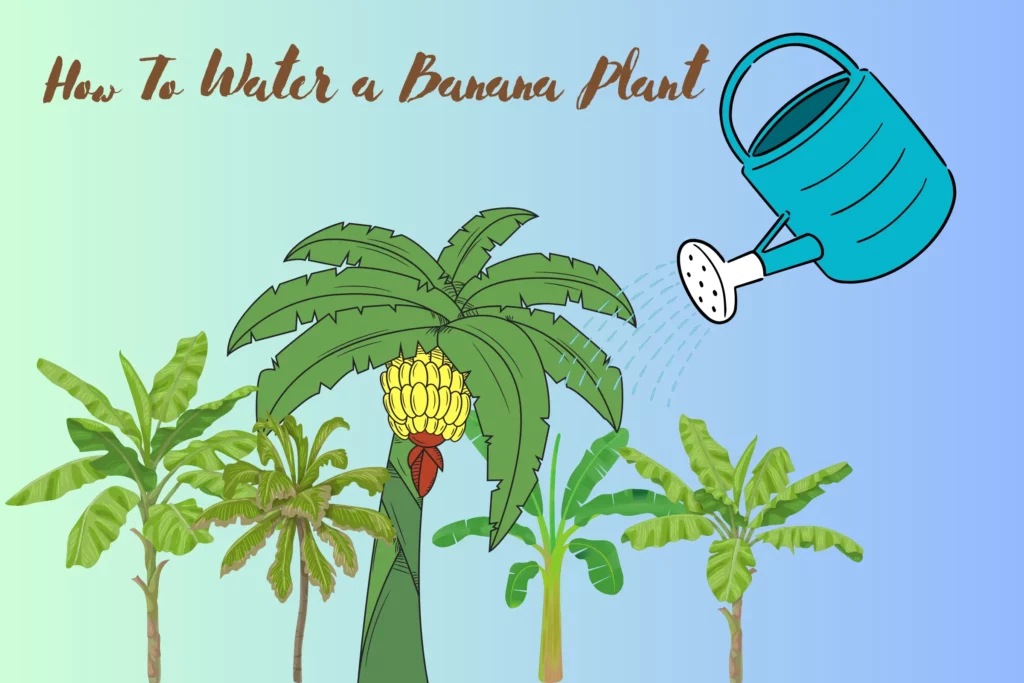
You should install an irrigation system if you have multiple banana plants in your garden. Consistent irrigation can also be achieved with sprinklers or drip lines.
How Do I Know If My Banana Tree Has Root Rot?
The first sign of root rot on a banana plant is yellowing or discoloration of the leaves, drooping, or wilting. Soft or mushy leaves can fall off the plant or become soft. A strange or unpleasant smell may accompany dark brown or reddish-brown leaves.
A root rot is caused by a fungus that grows on the root’s casings. Report potted banana plants in fresh soil and reduce watering. Rainwater can be regulated by mulching banana plants growing in the ground.
Mulch can be made from hay, straw, or bark. Mulch should be layered 2-3 inches thick around the root zone but away from the stems.
FAQ
Why Are The Lower Leaves On My Banana Plant Turning Yellow?
The lower leaves of banana plants may turn yellow if they do not receive enough nutrients from the soil. The low potassium content in the soil causes the leaves to turn yellow on the margins and tips. Magnesium deficiency can cause yellowing in the middle of the leaf.
Why Does My Banana Tree Look Droopy?
Overwatering, transplant shock, lack of sunlight, or carrying too much weight can cause drooping banana leaves. Underwatering and transplant shock are the most common causes. Provide your plant with 6+ hours of sunlight and well-draining soil to prevent droopy leaves.
Final Thoughts
Water is crucial for banana plants, but overwatering can harm their growth and health. Signs of overwatering banana plants include yellow or brown leaves, root rot, and stunted growth. To avoid these issues, it’s important to ensure that the soil is well-draining and that you water the plant only when necessary. Proper watering techniques can help keep your banana plant healthy and productive. By following the tips in this article, you can prevent overwatering and ensure your banana plant thrives.

